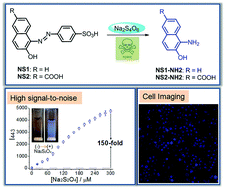Visualizing cellular sodium hydrosulfite (Na2S2O4) using azo-based fluorescent probes with a high signal-to-noise ratio†
Abstract
Developing a reliable method to detect Na2S2O4 in real time is of great importance for the in-depth study of its toxicity to humans and to allow it to be safely handled. Currently, research on the fluorescence imaging of Na2S2O4 is very scarce. Herein, we present azo-based turn-on fluorescent probes with a high signal-to-noise ratio (emission enhancement >100-fold) for the visualization of Na2S2O4 in living cells.



 Please wait while we load your content...
Please wait while we load your content...